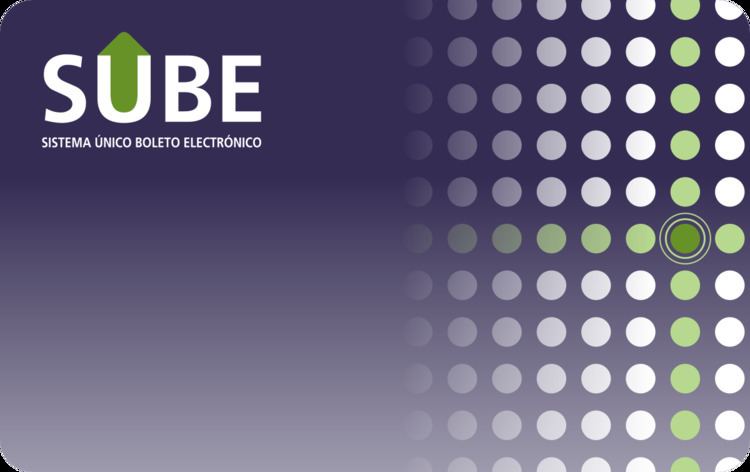Launched February 2009 Currency ARS | Operator Nación Servicios S.A Credit expiry None | |
 | ||
Location Being rolled-out nationwide. Technology | ||
The SUBE card (standing for Sistema Único de Boleto Electrónico; literal English translation: Unified Electronic Ticket System) is a contactless smart card system introduced in February 2009. It is used on public transport services within the Buenos Aires metropolitan area and was promoted by the Argentine Secretary of Transportation. It is valid on a number of different travel systems across the city including the Underground, buses and trains.
Contents
- Background
- Use
- Bus
- National Lines
- Province Lines
- Municipal Lines
- Buenos Aires Underground
- Trains
- Tolls roads
- Controversies
- References
One of the benefits of this change is that it has helped speed passengers on to the bus. People no longer had to wait to be issued a printed receipt as they each enter the bus. Environmentally this should help reduce emissions of carbon dioxide and nitrogen because buses don't have to idle as long while passengers load, helping improve air quality in the city. The electronic ticket is eliminating the printed receipts thus lowering the amount of littering in the city. The city, in turn, no longer have to process, collect, count, and transport coinage received in payment of some 11 million trips per day.
Background
Buenos Aires was affected for several years by an acute coin shortage that impacted the economy, banking, and transportation. Coins are still rationed by banks, and a thriving black market has been hoarding to sell coins illegally to retailers. Merchants have been rounding prices up or down according to the amount of change a customer actually has, or bartering, and making up the difference with a menial item. The fact that the vast majority of users need to purchase ahead sufficient credit for tickets and passes including highways tolls even for a complete month makes the SUBE card system carry a float of several million pesos which allows for financial backing of various activities at local government level. The system is administered by Banco de la Nacion Argentina.
Use
The SUBE card can be used on several transports method, including Greater Buenos Aires area Buses, Trains, Buenos Aires Metro, and several toll roads. Furthermore the system has expanded to the mayor cities of Argentina: among others Mar del Plata, Villa Gesell, Partido de La Costa, Pinamar, Bahía Blanca, Corrientes, Neuquén, Río Grande, Ushuaia, Formosa, Paraná y Santa Fe,
Bus
According to official SUBE website it can be used in all national, province and municipal buses lines within Greater Buenos Aires Area. Here is the full list:
National Lines
1, 2, 4, 5, 6, 7, 8, 9, 10, 12, 15, 17, 19, 20, 21, 22, 23, 24, 25, 26, 28, 29, 32, 33, 34, 36, 37, 39, 41, 42, 44, 45, 46, 47, 49, 50, 51, 53, 55, 56, 57, 59, 60, 61, 62, 63, 64, 65, 67, 68, 70, 71, 74, 75, 76, 78, 79, 80, 84, 85, 86, 87, 88, 91, 92, 93, 95, 96, 97, 98, 99, 100, 101, 102, 103, 104, 105, 106, 107, 108, 109, 110, 111, 112, 113, 114, 115, 117, 118, 123, 124, 126, 127, 128, 129, 130, 132, 133, 134, 135, 136, 140, 141, 143, 146, 148, 150, 151, 152, 153, 154, 158, 159, 160, 161, 163, 165, 166, 168, 169, 172, 174, 175, 176, 177, 178, 179, 180, 181, 182, 184, 185, 188, 193, 194, 195.
Province Lines
200, 202, 203, 204, 205, 214, 215, 218, 219, 222, 228, 236, 237, 238, 239, 242, 243, 245, 247, 252, 253, 256, 257, 263, 264, 266, 269, 271, 273, 275, 276, 277, 278, 281, 283, 284, 288, 289, 291, 293, 295, 297, 298, 299, 300, 304, 306, 307, 310, 311, 312, 313, 314, 315, 317, 318, 321, 322, 323, 324, 325, 326, 327, 328, 329, 333, 336, 338, 340, 341, 343, 350, 354, 355, 364, 365, 370, 371, 372, 373, 378, 379, 382, 383, 384, 385, 388, 391, 392, 394, 395, 403, 404, 405, 406, 407, 410, 418, 421, 422, 429, 430, 432, 435, 436, 437, 440, 441, 443, 445, 446, 448, 44.
Municipal Lines
Buenos Aires Underground
All lines including:
Trains
All the following lines:
Tolls roads
From the beginning of 2014, several tolls road could be paid by SUBE card:
Controversies
The project was led by Global Infrastructure (GI), owned by the British businessman Stephen Chandler. The Argentine newspaper La Nación noted that the fiscal address of GI had a hairdressing local, and their employees were not actually working for GI nor receiving the informed payments. The secretary of transport had also chosen Global Infrastructure despite being $10,000,000 more expensive than other offerings. La Nación also pointed out that GI did not exist before the tender. When all this info came to light, the contract with GI was cancelled.
